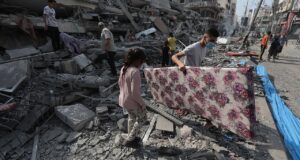By Simon Schofield – Senior Fellow
3rd July 2014. Security and Defence, Issue 3, No. 1.
We humans do have a strange way of dealing with illness at times. So many of us seem to take the ‘if it ain’t hanging off it’s probably fine’ approach to that twinging chest pain or that cough that has not gone away for a month. On an individual level this is irresponsible and can lead to serious health complications. However, if you treat a political affliction this way it is reckless and can lead to entire countries being torn asunder, which brings me in a rather round-about fashion to Iraq and the current ISIS offensive sweeping through Mosul into Baghdad.
A strange phenomenon identified in the Humanitarian Intervention Centre’s evidence to Parliament termed ‘the Zarqawi Syndrome’ is just such a problem. Like many medical maladies, having been ignored this Syndrome has not gone away by itself, but has become entrenched in the particular organisational culture of the now known as ISIS, the successor to organisation to al Qaeda in Iraq and is now threatening to violently open up religious fault lines in Iraq.
What is the Zarqawi Syndrome?
In a globalised world we have largely shed our 20th century skin, characterised by nationalist struggles and jingoism. The internet has brought us together in unprecedented and unforeseen ways. We can make friends with people thousands of miles away because of our shared interests in video games; we can talk about how Spain was dumped out of the World Cup unceremoniously with friends in Iran, who have played surprisingly well. Of course, these are rather moderate interests to pursue, and the internet has opened the same avenues for terrorists and revolutionaries the world over. As such we are now in a position where political causes are as globalised as the music industry or football.
Radical Islam is a globalised idea that is being drilled into the minds of many young Muslims from London to Cairo, from Yecheng to Grozny. Many of you will know the basic ideas of this ideology, but for ease they will be surmised here. Jihad (struggle) is mandatory against unbelievers, apostates (those who have abandoned Islam) and secularists. The political end-game is to establish a Caliphate, a theocratic regime led by a Caliph, one who has inherited the political authority of Mohamed, under whose guidance the Shariah will be implemented.
The Shariah is the pure political system put forward in the Qu’ran and Mohamed’s example (the Sunnah). For Westerners, objectionable interpretations of the Shariah propagated by such extremists include the notion that women are second class citizens who are neither to be educated, nor to be seen in public unless escorted by a male relative or their husband. It is compulsory for women to wear the Niqab or Burqa veil. Blasphemy or rejection of Islam is punished in extremely harsh terms. Many also engage in Takfirism, a practice not recognised by mainstream Islam, wherein those who refuse to partake in or support armed Jihad are declared ‘Takfir’ i.e. ‘not a real Muslim’ and are thereby subject to the same treatment as an apostate. Now naturally not all Muslims believe this and they are fighting their own battle to ensure that moderation prevails, but there are clearly enough preachers and militants to flood Syria and Iraq and still pose a threat in Russia, China, Europe and Africa simultaneously.
With this ideology drilled into their heads, mojahedin (those engaged in jihad) travel from wherever they have been raised and indoctrinated to wherever the latest battleground is, be it Iraq, Syria, Pakistan, Afghanistan, Yemen or perhaps somewhere that has yet to suffer such miserable conflict. However, with such black and white views of the world, and filled with such zealous and frenzied lust for battle, the mojahed will often fail to take into account local context and priorities and, unconcerned with preserving the integrity of the community, will visit unspeakable levels of violence on entire sections of the carnage-stricken society.
A strong example for this can be seen in al Shabaab. Al Shabaab was once the armed wing of the Union of Islamic Courts (UIC) in Somalia, who were fighting to establish a Caliphate in the Horn of Africa. However, al Shabaab split with the UIC after Ethiopia delivered a crushing defeat and threw them both out of Mogadishu. Al Shabaab sought to remedy the personnel shortage brought about by the split by shipping in hundreds of international jihadists. This swelled their ranks with experienced fighters from all over the globe (for more details see our HIC paper on al Shabaab) and helped them maintain their dominance on the Somali political scene. However, these Islamists fell prey to the Zarqawi Syndrome and began to increasingly favour attacks that specifically targeted civilians, which alienated many of those once sympathetic to the cause and ruptured many longstanding community ties.
The archetypal illustration of the Zarqawi Syndrome in practice is obviously its namesake. Abu Musab al Zarqawi was the leader of al-Tawhid wal-Jihad (Unity and Struggle), which was renamed al Qaeda in Iraq (and also went by the name of al Qaeda in the Land of Two Rivers) in 2004 until his death in 2006. Zarqawi, by his name, likely grew up in the Jordanian city of Zarqa, and is known to have gone to Afghanistan to help fight the Soviets, though the fighting was largely finished by the time he got there. According to the Guardian he was arrested back in Jordan after guns and explosives were found in his home and spent six years (1992-1998) in prison, where he is believed to have become ultra-radicalised.
Zarqawi was so enamoured with this Sunni extremist ideology that he embarked on a frenzied crusade with his followers, capturing foreign hostages and beheading them on video, including Kenneth Bigley and Nicholas Berg, before sensationally publicising them to traumatise others. At the same time as viciously drenching his hands in the blood of Westerners, he also began a campaign against Shiah Muslims in Iraq. In August 2003 he took responsibility for an attack on a Shiah shrine in Najaf, which killed 84.
Following the joint US-Iraqi Operation Black Typhoon in the town of Tal Afar, Zarqawi was so incensed and fearful that the Iraqi Sunnis would soon cooperate with the majority-Shiah government, abandoning the dream of Islamism, that he declared “all out war” on Shiah Muslims in Iraq. The hope was to spark a sectarian war between Sunni and Shiah, in order to render such cooperation completely impossible. To this end Zarqawi expanded al Qaeda in Iraq’s membership by merging with other Sunni militant organisations under an umbrella organisation known as the Mojahedin Shura Council. This was largely unsuccessful, due to Zarqawi’s proclivity for extreme violence against civilians and radical interpretation of Islam.
The resulting bloodbath was so violent even al Qaeda’s central leadership chastised Zarqawi. It is believed that Osama Bin Laden’s deputy in 2005, who now leads al Qaeda, Dr. Ayman al-Zawahiri wrote Zarqawi a letter, telling him that indiscriminate attacks on the Shiah population were eroding support for the movement. Even Hezbollah condemned his disregard for civilian lives.
On 7th June 2006 Zarqawi was killed by two 500lb bombs dropped US F-16C jet fighters dropped on a safe house in which he was holding a meeting. The names of al Qaeda in Iraq and the Mojahedin Shura Council effectively died with him.
In order to try and shake off the reputation of being foreign, Sunni militants with a thirst for blood and to try and put forward a more Iraqi image with a broader Islamic appeal, Zarqawi’s replacement Abu Amer al-Baghdadi rebranded the Mojahedin Shura Council as the Islamic State of Iraq (ISI). With Zarqawi out of the picture ISI continued to go with the tactic of widespread carnage against civilian and government targets, but became indiscriminate, rather than focusing on Shiah communities. Particularly brutal attacks in 2007 were the bombing of the Iraqi Parliament and the co-ordinated car-bombings of the Yazidi communities in Nineveh province, which killed around 800. However, contrary to shattering the power of the Iraqi state and rallying Sunnis and extremists around the Black Flag, it angered many local communities, and ISI splinter groups and anti-ISI militia sprung up, which often collaborated with the Iraqi authorities and the US forces, including the Anbar Awakening Council. Again here the Zarqawi Syndrome still had a stranglehold of the group and it harmed the long term strategic achievement of the organisation, as these setbacks left them completely unable to resist the joint US-Iraqi offensives which drove them out of their strongholds in Diyala and Anbar province.
The first al-Baghdadi ISI leader died along with Abu Ayub al Masri, another ISIS commander in 2010 in a rocket attack on house near Tikrit in Northern Iraq. Al-Baghdadi was then replaced by Abu Bakr al-Baghdadi (no relation), a meticulously quiet and discreet character, who even wears a mask to address his followers, earning the nickname ‘the invisible sheikh’. Whilst almost the opposite of Zarqawi in the sense that al-Baghdadi is not the theatrical showman, preferring concrete territorial gains and effective business models to the video broadcast psychodrama of al Qaeda in Iraq, al-Baghdadi’s ISI is not immune to the Syndrome.
When the Arab Spring in Syria was Jihadified and al Qaeda sought to stamp its own authority on the conflict the al Nusra front was established. Shortly thereafter, in April 2013, al-Baghdadi announced that al Nusra had been established at the behest, and using the resources of, the ISI and that the two groups would be merging under the banner of the Islamic State of Iraq and al-Sham (or (Greater) Syria) – ISIS. Al Nusra leader Abu Muhammad al-Jawlani rejected the merger, claiming not to have been consulted on it and obtained the backing of al Qaeda leader Ayman al-Zawahiri. In the ensuing infighting hundreds were killed and ISIS seized the key city of Raqqa from al Nusra, where the offensive into Iraq is believed to have been planned. Both sides refused to budge on this and ultimately al Qaeda disavowed ISIS, citing that they were ‘too extreme’. This is where the Zarqawi Syndrome led ISIS, to being declared too extreme for the group that organised and carried out 9/11, the single most devastating act of murder against civilians the world has ever known. Of course, in the last 24 hours it would appear the al Nusra and ISIS have resolved their issues and are now going to reunite, likely because of tensions between al Nusra and local rebels and also in light of the stunning territorial gains ISIS has made in recent days and weeks.
Al Qaeda and other insurgent groups typically aim to terrorise their enemies, but also to win over swathes of the population, in order to hold governable territory without risk of uprising or collaboration with counterinsurgency forces. However ISIS’s proclivity for extreme violence has, historically, hampered them at every stage in their development. Without a distinct change in strategy they will struggle to continue their expansion and hold/govern the territory they have seized in the long term.
Simon Schofield is contactable at:
Simon.Schofield@hscentre.org
Please cite this article as:
Schofield, S. (2014). ‘Zarqawi Syndrome is Alive and Kicking – Even if its Namesake Isn’t’
Human Security Centre, Defence and Security, Issue 3, No. 1.
 Human Security Centre Human Rights and International Security Research
Human Security Centre Human Rights and International Security Research




